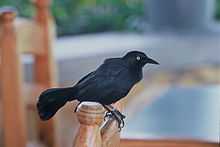Greater Antillean grackle
| Greater Antillean grackle | |
|---|---|
 | |
| Puerto Rican subspecies Q. n. brachypterus | |
| Conservation status | |
| Scientific classification | |
| Kingdom: | Animalia |
| Phylum: | Chordata |
| Class: | Aves |
| Order: | Passeriformes |
| Family: | Icteridae |
| Genus: | Quiscalus |
| Species: | Q. niger |
| Binomial name | |
| Quiscalus niger (Boddaert, 1783) | |
 | |
| Range of Q. niger | |
The Greater Antillean grackle (Quiscalus niger) is a grackle found throughout the Greater Antilles and the Cayman Islands as well as smaller, nearby islands. Like all Quiscalus grackles, it is a rather large, gregarious bird.[2] It lives largely in heavily settled areas.
Appearance
The 27 cm (11 in) long male is glossy black with a large rudder-like tail; the 24 cm (9.4 in) long female has a smaller tail and is similar in colour but less glossy than the male. The eye is yellow and is the only non-black body part.
There are seven subspecies, each restricted to one island or island group.[3] They differ from the nominate Q. n. niger subspecies in size, bill size and colour tone.
- Q. n. caribaeus – (Todd, 1916): found in western Cuba and on Isle of Pines
- Q. n. gundlachii – Cassin, 1867: found in central and eastern Cuba
- Q. n. caymanensis – Cory, 1886: found on Grand Cayman Island
- Q. n. bangsi – (Peters, JL, 1921): found on Little Cayman Island
- Q. n. crassirostris – Swainson, 1838: found in Jamaica
- Q. n. niger – (Boddaert, 1783): nominate, found on Hispaniola
- Q. n. brachypterus – Cassin, 1867: found in Puerto Rico
Nicknames
It is very friendly towards humans and is known on various islands as cling-cling, chango, chinchilín, and iguana bird.[4] The locals, and especially tour guides in San Juan, Puerto Rico, sometimes make fun of the tourists by telling them the birds are iguana-eating carnivores released by the government in response to the iguana epidemic[5] on the island, hence the name iguana bird.[6] In areas where Greater Antillean grackles are less prevalent, such as some parts of Mexico, guides have different names for the bird.[7]
Gallery
-

Adult
-

In San Juan, Puerto Rico
-
.jpg)
In Cuba
-
_RWD.jpg)
In Puerto Rico
-

In Puerto Rico
-

In Jamaica
See also
- Fauna of Puerto Rico
- List of Puerto Rican birds
- List of Vieques birds
References
- ↑ BirdLife International (2012). "Quiscalus niger". IUCN Red List of Threatened Species. Version 2013.2. International Union for Conservation of Nature. Retrieved 26 November 2013.
- ↑ Bond, James (1993). Birds of the West Indies (fifth ed.). Houghton-Mifflin. ISBN 978-0618002108.
- ↑ Gill, F.; Donsker, D., eds. (2014). "IOC World Bird List". IOC World Bird List (v 4.2). doi:10.14344/IOC.ML.4.2.
- ↑ Jaramillo, Alvaro; Burke, Peter (1999). New World Blackbirds: The Icterids. Princeton University Press. ISBN 978-0691006802.
- ↑ Campo-Flores, Arian (12 August 2012). "To Battle Iguanas, Puerto Rico Has New Plan: Put Them on Menu". Wall Street Journal. Retrieved 2 November 2013.
- ↑ "Greater Antillean Grackle". oiseaux-birds.com. Retrieved 12 April 2013.
- ↑ "What is a Grackle?". 10000birds.com. 27 November 2009.
External links
| Wikimedia Commons has media related to Quiscalus niger. |
| Wikispecies has information related to: Quiscalus niger |
- BirdLife species factsheet for Quiscalus niger
- Greater Antillean grackle videos, photos, and sounds at the Internet Bird Collection
- Greater Antillean grackle photo gallery at VIREO (Drexel University)
- Greater Antillean grackle species account at NeotropicalBirds (Cornell University)
